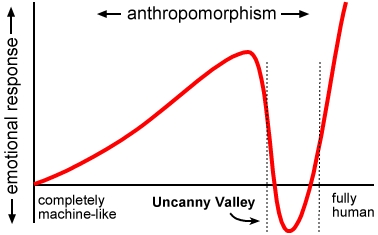Uncanny valley

The term 'uncanny valley' refers to a situation in which something bears realistic human appearance (or movement), yet appears uncanny or repulsive to observers. The hypothesis is, that as a subject's appearance becomes more realistic it will tend to engender progressively more familiarity in the viewer- except for a small period just before the likeness is perfect, wherein the subject instead appears repulsive.
The "valley" refers to the dip that occurs if the concept is plotted as a graph of familiarity (y-axis) as a likeness becomes more realistic (x-axis). (See Fig.1)
Source[edit]
The term was coined by robotics professor Masahiro Mori in 1970[2], and first appeared in print in the 1978 book Robots: Fact, Fiction, and Prediction by Jasia Reichardt[3]. The term has gained popularity with the advent of 3D animation, where it is often used to describe computer generated characters that are intended to look perfectly life-like, but fall short and look disturbing instead.
Relevance to Virtual Reality[edit]
The concept of the uncanny valley is particularly relevant to virtual reality because the 3D graphics which are a staple of virtual environments often exhibit the phenomena when life-like avatars or characters are used. While cinematic 3D renderings have largely progressed past the point of evoking revulsion, the computational constraints of rendering in real-time for virtual reality mandate less complex results, which makes it difficult to create samples that are sufficiently lifelike to move past the uncanny valley.
Possible Solutions[edit]
Until real-time rendering for stereo output can computationally support the complex simulations needed to present a photo-realistic human, the best solution available to developers of virtual environments is to stay to the left of the uncanny valley. By using characters and avatars with exaggerated or stylized features a developer can create functional characters that avoid being 'not-quite perfect' and unsettling to observers.
References[edit]
- ↑ http://www.johnmckenziehypnotherapist.co.uk/uncanny-valley/
- ↑ Kawaguchi, Judit (10 March 2011). "Robocon founder Dr. Masahiro Mori". Words To Live By. Japan Times. p. 11.
- ↑ "An Uncanny Mind: Masahiro Mori on the Uncanny Valley and Beyond". IEEE Spectrum. 12 June 2012